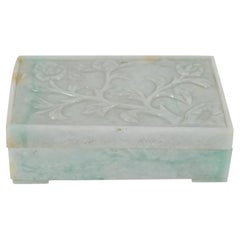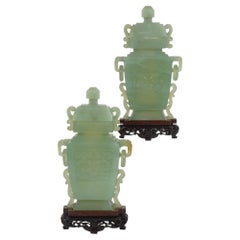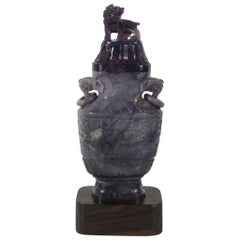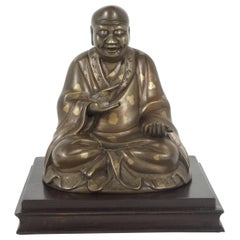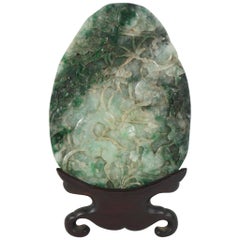Gottlieb Gallery Sculptures and Carvings
15
to
15
15
15
15
8
7
4
3
9
7
5
4
4
15
14
12
1
1
Chinese Carved Jadeite Cigarette Box and Cover
Located in Hudson, NY
Made in the late Republic Period, circa 1945 to 1950, this box was purchased in China in 1990. The boxes carved jadeite ranges from a lovely soft translucent white to a rich green in veins that crisscross the stone with some natural brownish inclusions in the stone as well. Carved in a typical rectangular form conforming to the shape of the product for which it was designed the lid is centered with a flowering prunus branch set within a raised lip...
Category
Mid-20th Century Chinese Sculptures and Carvings
Materials
Jade
Pair of 20th Century Chinese Carved Bowenite Lidded Urns.
Located in Hudson, NY
This nice pair of carved lidded urns are made form Bowenite which is considered a semiprecious stone and thought to resemble jade. They were carved in the mid 20th century and come w...
Category
Mid-20th Century Chinese Sculptures and Carvings
Materials
Stone
Three Early 20th Century Red Horn Carvings of Buddha and Bodhisattva
Located in Hudson, NY
Three early 20th century red horn carvings of Buddha and Bodhisattvas. These three carvings all from approx. circa 1915 represent the bodhisattvas and or the ...
Category
Early 20th Century Chinese Busts
Materials
Horn, Rosewood
Chinese Republic Period Carved Amethyst Quartz Vase with Cover
Located in Hudson, NY
This urn, while archaistic in shape, generally is far more typical of 18th and 19th century specialty carved hardstone vases. The carving in rich veined amethyst quartz was done circa 1930-1940 and is dominated on the lid with a Kylin or mythical beast that in Chinese culture represents good luck and prosperity. The lid its self is ribbed and rests on the top of the urn between two further Kylin heads holding in there mouth loose rings. The main body of the vase is covered in Taotie masks in a stylized form. The foot of the urn, as well as the shoulder above the main body, are carved with lambrequins inset with traditional Chinese repetitive patterns often found on ancient dynastic...
Category
Mid-20th Century Chinese Sculptures and Carvings
Materials
Amethyst
Late 19th Century Chinese Gold Fleck Cast Bronze Figure of Buddha
Located in Hudson, NY
This work cast in bronze with a gold fleck finish to the clothing was made in the last quarter of the 19th century. The patina and color of the figure has lovely rub through and sits...
Category
Antique Late 19th Century Chinese Sculptures and Carvings
Materials
Bronze
Early 20th Century Chinese Qing Dynasty Large Jadeite Carved Plaque on Stand
Located in Hudson, NY
This very nice carved plaque of good size comes from China and was made circa 1900. The stone is a rich combination of dark, light and emerald green. Sliced from a boulder washed and...
Category
Early 20th Century Chinese Qing Sculptures and Carvings
Materials
Jade
19th Century Japanese Silver Inlayed Bronze Representing Daikoku
Located in Hudson, NY
From the Estate of Paul & Clara Kellner. This large bronze of Daikoku or the God of Prosperity closely associated with farmers, agriculture and rice staples of Japanese life and stability. His attributes are a co-mingling of Indian Buddhist forms of Shiva and the Shinto God...
Category
Antique Late 19th Century Japanese Sculptures and Carvings
Materials
Silver, Bronze
19th Century Tibetan Patinated Bronze Figure of Tara on New Black Base
Located in Hudson, NY
This fine old bronze of Tara was made for the purpose of focusing on the process of meditation regarding her aspects of wisdom and compassion. Crafted in Tibet but nearer to India and its influences this figure is an interesting combination of Hindu and Buddhist art and religion. Originally Tara was conceived as a Hindu mother goddess with the spread of Buddhism she was redesigned sometime after 4th century giving her a new role within the spreading Buddhist religion. This seems to have taken place in Shri Lanka and then spread out and back into India and Tibet thru China. At this time Shri Lanka was a great trading center and was host to many religious aspects, sects and ideals. The figure is cast with many fine details and is patinated in a warm green, brown showing traces of a coppery red color. The bronze content of this figure has a high amount of copper in the smelting giving the bronze a rich internal red color. Seated in lalitasana with her pendent right foot resting on a separately cast Padma or lotus pillow...
Category
Antique Mid-19th Century Tibetan Tibetan Sculptures and Carvings
Materials
Bronze
Early 19th Century Chinese Carved Agate Urn Set on a French Gilt Base
Located in Hudson, NY
This fine Chinese urn carving from the early 19th century has been in the late 19th century placed on a carved wood base that has been gilded creating a dramatic foil for the carving...
Category
Antique Early 19th Century Chinese Qing Sculptures and Carvings
Materials
Agate
Late 19th Century Chinese Glazed Terracotta Seated Luohan Figure
Located in Hudson, NY
This hand-shaped and incised terracotta Luohan or seated figure of a scholar was made in China at the end of the imperial dynastic period circa 1900. Luohan or a term for an Arhat who are the historical disciples of the Buddha. These figures have been seen throughout Buddhistic artist tradition for as long as the Buddhas religious teachings have existed. The figure seated on a rock rests...
Category
Antique Late 19th Century Chinese Qing Sculptures and Carvings
Materials
Terracotta, Wood
Late 19th century Carve Stone Cambodian Buddha
Located in Hudson, NY
This sage green carved stone Buddha was purchased from an upstate NY garden where it has resided for the last 120 years. The family began the house and garden in the late 1890s and traveled through China, Southeast Asia and Europe acquiring objects to create a complete retirement home for themselves and their family from New York City. Sculptures like this are a typical form found at Angkor of numerous sizes representing Nagas and used as guardians of temples. This figure was a favorite motif of Angkorean sculptors from the 12 century...
Category
Antique 1890s Cambodian Other Sculptures and Carvings
Materials
Stone
Late 19th/Early 20th Century Carved Jade Mythical Bird Carving
Located in Hudson, NY
This nicely carved bird figure is done in an 18th-century style but is from the very late 19th century to early republic period. The stone is a soft mellow celadon green with dark br...
Category
Early 20th Century Chinese Sculptures
Materials
Jade
19th Century Chinese Bronze Dancing Figure
Located in Hudson, NY
The charming figure done completely in the lost wax method is in a primitive naive style. The male figure is dancing excitedly on a rocky outcrop. His costume of a loose-fitting coat...
Category
Antique 19th Century Chinese Sculptures
Materials
Bronze
19th Century Nephrite Jade Carved Plaque on Stand
Located in Hudson, NY
This carved Nephrite Jade plaque of a mythical best has the attributes of a dragon and a fish leaping from the water. Carved we believe in the late 18th or early 19th century to be u...
Category
Antique 19th Century Chinese Sculptures
Materials
Jade
Late 19th or Early 20th C. Carved Jade Urn
Located in Hudson, NY
This fine jade urn of a lovely spinach color running to a deep yellow is carved to resemble a pair of Buddhist lions or mythical beasts conjoined back to back...
Category
Early 20th Century Chinese Urns
Materials
Jade
Related Items
Japanese Meiji Period Carved Wood Okimono Man with Rabbits
Located in Newark, England
The charming figure, carved from a single piece of wood is exceptionally carved showing the male figure with humorous expression holding two Rabbits one by the ears and the second under his arm. A third Rabbit stands at the feet of the male looking up, each rabbit with a different expression. The male figure is wearing traditional Japanese attire with his hair tied back stood upon a naturalistic base. The figure dates to the Meiji Period (1868-1912) circa 1900.
Notes The Rabbit is one of the 12 animals to feature in the Japanese Zodiac signs which follows the Chinese astrological system along with the Rat, Ox, Tiger, Rabbit, Dragon, Snake, Horse, Goat, Monkey, Rooster, Dog, Pig. Such division is connected with the Jupiter cycle around the Sun, which lasts about 12 years. As 2023 is the year of the Rabbit...
Category
Antique Early 1900s Japanese Meiji Sculptures and Carvings
Materials
Wood
Singa Guardian Sculpture from the Batak Tribe of Sumatra, Early 20th Century
Located in Jimbaran, Bali
A Batak Tribe “Singa” from the Indonesian island of Sumatra. This mythical lion figure was used as a protective architectural element on the corner of a traditional Batak house. It f...
Category
Early 20th Century Indonesian Other Sculptures and Carvings
Materials
Wood
H 57.09 in W 15.36 in D 14.57 in
Chinese Phoenix Bird and Dragon Box
Located in New York, NY
A black and off-white Chinese phoenix bird and dragon decorative plastic box with lid, circa 20th century, China.
Box measures: 4.25" D x 8.25" ...
Category
Mid-20th Century Chinese Decorative Boxes
Materials
Plastic
Antique Chinese Carved Soapstone Spill Vase
Located in Forney, TX
An exceptionally hand-carved antique Chinese soapstone spill vase - spill holder (see below), profusely decorated and intricately detailed naturalistic sc...
Category
20th Century Sculptures and Carvings
Materials
Soapstone
Pair Antique Chinese Carved Celadon Jade Guardian Lions ROC Early 20th Century
Located in Richmond, CA
This exquisite pair of celadon jade guardian lions hails from the early Republic of China period, a testament to the era's craftsmanship. The lions are intricately carved from high-q...
Category
Early 20th Century Chinese Chinese Export Sculptures and Carvings
Materials
Jade
No Reserve
H 3.55 in W 1.97 in D 2.76 in
Chinese White Jade Open Late Qing Dynasty Plaque
By Alba China
Located in Gainesville, FL
Chinese white jade openwork plaque late Qing Dynasty depicting birds and flowers. Very fine and detailed work. Small loss on the back side of the pl...
Category
Antique 19th Century Chinese Chinese Export Sculptures and Carvings
Materials
Jade
Carved Polychromed Chinese Horse
Located in Palm Springs, CA
A wonderful 20th century carved painted wooden Chinese horse purchased in 1985 from a prominent Hong Kong Gallery. A copy of the original receipt will be...
Category
20th Century Chinese Sculptures and Carvings
Materials
Wood
Larger Than Life Terracotta Buddha Bust of Guanyin, Early 20th Century, China
Located in Antwerp, BE
A massive larger than life terracotta buddha bust of Guan Yin,
China, early 20th century.
Broken and restored with wear and tear from enduring exposure to the elements.
Size: 75 cm high.
Weight: 40 kg.
Guanyin, Kwanyin, Guanshiyin or Guanyin Pusa is the Chinese interpretation of the bodhisattva Avalokiteśvara (the goddess of comfort and mercy). In addition, she is seen in Taoism as an immortal. The scripture dedicated to her is Dabeizhou. Guanyin is the goddess of compassion and the sea. She is one of the three saints of the western paradise, along with Mahasthamaprapta and Amitabha Buddha; they are worshiped to save departed loved ones from hell and grant them entrance to the western paradise.
Guanyin
Chinese name
Traditional Chinese 觀音
Simplified Chinese 观音
Transcriptions
Full Chinese name
Traditional Chinese 觀世音
Simplified Chinese 观世音
Literal meaning "[The One Who] Perceives the Sounds of the World"
Transcriptions
Second alternative Chinese name
Traditional Chinese 觀自在
Simplified Chinese 观自在
Literal meaning "Lord who Gazes down on the World"
Transcriptions
Burmese name
Burmese ကွမ်ယင်
IPA [kwàɴ jɪ̀ɴ]
Tibetan name
Tibetan སྤྱན་རས་གཟིགས
Vietnamese name
Vietnamese alphabet Quan Âm (Quán Âm)
Quán Thế Âm (Quan Thế Âm)
Quán Tự Tại
Chữ Hán 觀音
觀世音
觀自在
Thai name
Thai กวนอิม, พระอวโลกิเตศวรโพธิสัตว์
RTGS Kuan Im, Phra Avalokitesuan
Korean name
Hangul 관음, 관세음, 관자재
Hanja 觀音, 觀世音, 觀自在
Transcriptions
Mongolian name
Mongolian script ᠨᠢᠳᠦ ᠪᠡᠷ
ᠦᠵᠡᠭᠴᠢ
Japanese name
Kanji 観音, 観世音, 観自在
Hiragana かんのん, かんぜおん, かんじざい
Transcriptions
Indonesian name
Indonesian Kwan Im, Kwan She Im, Awalokiteswara
Filipino name
Tagalog Guanyin (ᜄᜓᜀᜈᜌᜒᜈ)
Sanskrit name
Sanskrit अवलोकितेश्वर (Avalokiteśvara)
Khmer name
Khmer អវលោកិតេស្វរៈ (Avalokitesvarak), អវលោកេស្វរៈ (Avalokesvarak), លោកេស្វរៈ (Lokesvarak)
Hmong name
Hmong Kabyeeb, Niam-Txiv Kabyeeb, Dabpog, Niam-Txiv Dabpog
Guanyin (traditional Chinese: 觀音; simplified Chinese: 观音; pinyin: Guānyīn) is a Bodhisattva associated with compassion. She is the East Asian representation of Avalokiteśvara (Sanskrit: अवलोकितेश्वर) and has been adopted by other Eastern religions, including Chinese folk religion.[note 1] She was first given the appellation "Goddess of Mercy" or "Mercy Goddess" by Jesuit missionaries in China.[1] Guanyin is short for Guanshiyin, which means "[The One Who] Perceives the Sounds of the World."[2] On the 19th day of the sixth lunar month, Guanyin's attainment of Buddhahood is celebrated.[3]
Some Buddhists believe that when one of their adherents departs from this world, they are placed by Guanyin in the heart of a lotus, and then sent to the western pure land of Sukhāvatī.[4] Guanyin is often referred to as the "most widely beloved Buddhist Divinity"[5] with miraculous powers to assist all those who pray to her, as is mentioned in the Pumen chapter of Lotus Sutra and Kāraṇḍavyūha Sūtra.
Several large temples in East Asia are dedicated to Guanyin, including Shaolin Monastery, Longxing Temple, Puning Temple, Nanhai Guanyin Temple, Dharma Drum Mountain, Kwan Im Thong Hood Cho Temple, Shitennō-ji, Sensō-ji, Kiyomizu-dera, Sanjūsangen-dō, and many others. Guanyin's abode and bodhimaṇḍa in India is recorded as being on Mount Potalaka. With the localization of the belief in Guanyin, each area adopted their own Potalaka. In Chinese Buddhism, Mount Putuo is considered the bodhimaṇḍa of Guanyin. Naksansa is considered to be the Potalaka of Guanyin in Korea. Japan's Potalaka is located at Fudarakusan-ji. Tibet's Potalaka is the Potala Palace. Vietnam's Potalaka is the Hương Temple.
There are several pilgrimage centers for Guanyin in East Asia. Putuoshan is the main pilgrimage site in China. There is a 33 temple Guanyin pilgrimage in Korea which includes Naksansa. In Japan, there are several pilgrimages associated with Guanyin. The oldest one of them is the Saigoku Kannon Pilgrimage, a pilgrimage through 33 temples with Guanyin shrines. Guanyin is beloved by most Buddhist traditions in a nondenominational way and found in most Tibetan temples under the name Chenrézik (Wylie: Spyan ras gzigs). Guanyin is also beloved and worshipped in the temples in Nepal. The Hiranya Varna Mahavihar located in Patan is one example. Guanyin is also found in some influential Theravada temples such as Gangaramaya Temple, Kelaniya and Natha Devale nearby Temple of the Tooth...
Category
Early 20th Century Chinese Chinese Export Sculptures and Carvings
Materials
Terracotta
H 30.71 in W 22.84 in D 14.57 in
Antique Chinese Cinnabar Box
Located in Miami, FL
A fine antique Chinese red cinnabar lacquer lidded round box carved with a scene with a young boy and a seated elderly bearded sage within a rocky landscape with trees. The "dragon's...
Category
Antique 19th Century Chinese Qing Lacquer
Materials
Lacquer
Chinese Taoist Carved Wood Deity, Ming/Qing Dynasty, mid 17th century, China
Located in Austin, TX
A charming Chinese carved wood figure of a Taoist deity, possibly for a home or personal shrine, late Ming or early Qing Dynasty, mid 17th c...
Category
Antique Mid-17th Century Chinese Qing Sculptures and Carvings
Materials
Wood
H 9.75 in W 4 in D 2.5 in
Antique Chinese Cinnabar, Brass and Enamel Box
Located in Miami, FL
A crisply carved antique Chinese red cinnabar lacquer lidded round box with blue enamel interior and brass fittings. The "dragon's blood" trinket box has a fine peony, foliate and fl...
Category
Antique 19th Century Chinese Qing Lacquer
Materials
Enamel, Brass
Pair Early 20th Century Chinese Ceramic Foo Dogs
Located in Silvolde, Gelderland
Low fired ceramic Chinese "Ming" style pair matching Foo Dogs with beautiful cracked and dripped glazed four color finish.
This beautiful couple Foo Dogs is visibly handmade because the prints of the fingers the artist are visible in the earthenware.
These Foo Dogs makes displayed in your place a great...
Category
Early 20th Century Chinese Ming Ceramics
Materials
Earthenware
